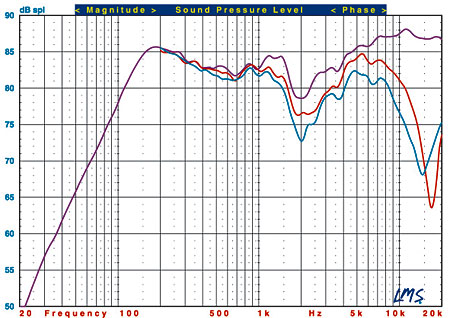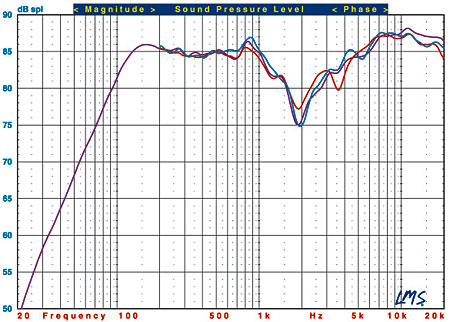Sunfire HRS Speaker System Measurements
Text by Thomas J. Norton
The measurements shown were taken with the grilles removed. The measured responses with the grilles in place (not shown) were nearly identical on-axis. The nominal impedances were determined from interpretation of the measured impedance curves (not shown).
All figures: Violet curve = pseudo-anechoic response on the tweeter axis, averaged across a 30° horizontal window, combined with nearfield responses of the woofer(s). All measurements were taken at 1 meter.
HRS SAT4
Minimum impedance: 4.68Ω at 231Hz
Nominal impedance: 6Ω
Cabinet tuning: 125Hz
Effective bass extension (-10dB): 88Hz (relative to the level at 180Hz)
Sensitivity: 84dB/2.83V/m
With its relatively high impedance, I would judge the HRS SAT4 to be relatively easy for any competent amplifier. But the low sensitivity suggests that low-power amps should be used only if your room is small and/or your preferred listening levels are modest.

Fig. 1: HRS SAT4, pseudo-anechoic response, off-center in the horizontal plane, at 45° (red) and 60° (blue).
The measured response of the SAT4 indicates a rising top end, a suckout at 2kHz (just above the specified crossover frequency), and very limited bass extension. Obviously, a subwoofer is mandatory with this speaker. The rapid rolloff in response below about 180Hz also suggests that a higher-than-usual crossover frequency to the sub—which could be tricky to properly achieve some situations—may be needed to produce a uniform blend and avoid a thin midbass. These comments also apply to the HRS SAT4C.

Fig. 2: HRS SAT4, pseudo-anechoic response at 15° above (red) and 15° below (blue) the tweeter axis.
The listening height should be non-critical as long as you remain at tweeter height or a reasonable angle above.
HRS SAT4C
Minimum impedance: 5.94Ω at 225Hz
Nominal impedance: 8Ω
Cabinet tuning: 108Hz
Effective bass extension (-10dB): 76Hz (relative to the level at 150Hz)
Sensitivity: 85dB/2.83V/m
The impedance results indicate that the SAT4C is an easy load to drive.

Fig. 3: HRS SAT4C, pseudo-anechoic response, off-center in the horizontal plane, at 45° (red) and 60° (blue).
The center-channel speaker's averaged response (violet curve, Fig. 3) is smoother than the SAT4 through the midrange, up to approximately 1kHz. The rising top end remains, however, along with a deeper suckout at 2kHz and off-axis dips slightly below that frequency, which is common with horizontally arrayed, woofer-tweeter-woofer center-channel speakers. Like the SAT4, this speaker needs a subwoofer and some care in choosing the crossover frequency.

Fig. 4: HRS SAT4C, pseudo-anechoic response at 15° above (red) and 15° below (blue) the tweeter axis.
The vertical response shows the 2kHz dip more prominently, but it also shows that the listening height for the center speaker is not critical.
The main response aberration in both of these speakers is the suckout or dip at about 2kHz. This could result in a laid-back quality to the sound and perhaps reduced speech intelligibility, though Gary did not hear any problem with dialog in his acoustically treated listening room.
- Log in or register to post comments




































































